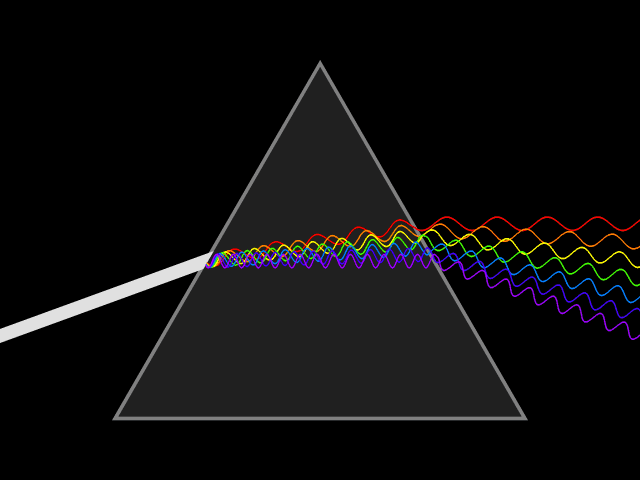Dispersion and Scattering of light
In this article, we will study about the phenomenon of dispersion and scattering of light, and also the colours the white light is made of.
 Table of Contents
Table of Contents- Dispersion of Light
- Scattering of light
- Colours
Dispersion of Light
When a beam of light passes through an optical medium (such as a prism), it not only deviates from its original path, it also splits up into its constituent colours. For example, a white beam of light splits up into a coloured band of seven colours. This phenomenon of splitting up of light into its constituent parts is called dispersion of light.

 Note
NoteIn fact, it was Sir Isaac Newton who observed dispersion of light in the emergent rays, when a narrow beam of light was incident on a prism.
Visible spectrum of light
The coloured band or pattern of seven colours, Violet, Indigo, Blue, Green, Yellow, Orange and Red, is called the visible spectrum of light. These seven colours (each of which is made up of electromagnetic waves of various wavelengths) are the components of white light, and we can memorize them using a mnemonic - VIBGYOR.
 Note
NoteThe visible spectrum of light is only a small part of the entire electromagnetic spectrum. A large part of the electromagnetic spectrum is not visible to human eye, e.g. γ-rays to radio waves. That’s because human eye can only see electromagnetic waves of a certain range of wavelengths/frequencies. Electromagnetic waves of very high or low wavelengths/frequencies cannot be seen by humans.
Angle of deviation
Angle of deviation (δ) is the angle subtended between the incident ray and emergent ray.

The angle/degree of deviation of waves of different colours will be different. Let’s find out why.
Dispersion of a light ray takes place because the refractive index of a medium for different wavelengths (colours) is different. Less the wavelength, the more the refractive index, and the more the light ray will deviate.
Every colour has a different wavelength. In the visible spectrum, red light is at the long wavelength end (~700 nm), while the violet light is at the short wavelength end (~400 nm). It means that:
- In the visible spectrum, refractive index of glass is maximum for violet colour light. So, violet colour ray will deviate the most, i.e. its angle of deviation will be the maximum.
- In the visible spectrum, refractive index of glass is minimum for red colour light. So, red colour ray will deviate the least, i.e. its angle of deviation will be the minimum. (Equivalently, red light travels faster than violet light in a glass prism).
 Note
NoteThe variation of refractive index with wavelength is not same for each medium. It may be more in some medium than the other. In fact, in vacuum (or air approximately) the speed of light is independent of wavelength (i.e. all colours travel with the same speed); so refractive index of light waves of any wavelength is almost the same in vacuum. That’s why white light from our sun does not get dispersed, even after passing through vacuum of space and air in Earth’s atmosphere. It reaches us as white light and not as a rainbow of its component colours. That’s why we call such medium as non-dispersive medium. On the other hand, medium such as glass are dispersive medium.
Examples of Dispersion of Light
Apart from the dispersion of light by glass prism, we can witness this phenomenon in various other natural and man-made scenarios. Let’s list down a few of them.
Rainbow
We all must have seen a rainbow in the sky after a shower of rain at least once in our lifetime. It’s a circular band of seven colours.
A rainbow is formed when sunlight is dispersed by water droplets suspended in air. That’s why a rainbow is formed in the sky opposite to the sun.
 Note
NoteIn each drop of water, dispersion of the sunlight and then internal reflection takes place.
Chromatic Aberration
Chromatic Aberration is a common defect in the image formed by a lens. Herein, the image of a white object formed by a lens is usually coloured and blurred.
The reason behind this phenomenon is that the refractive index of the lens material varies with the wave length (i.e. colour) of the light.
Scattering of light
Scattering of light means the change in direction of light after encountering an hinderance.
For example, earth’s atmosphere is filled with small particles, whose size is of the order of the wavelength of light. As sunlight travels through the atmosphere, it gets scattered after striking these particles.
Can you guess what kind of light will get scattered the most?
Well, the answer to this question is pretty simple. Just look up at the sky!
The shorter the wavelength of a light ray, the more it will get scattered. It mathematical terms, the amount of scattering is inversely proportional to the fourth power of the wavelength (known as Rayleigh scattering).
It means that:
- Violet and Blue lights, that have shorter wavelengths, get scattered the most. That’s why the sky looks blue. (though other colours also get scattered to some extent, blue colour predominates)
- Red light, that has longer wavelength, gets scattered the least. That’s why we often use red light for danger signals – as they get scattered the least in the atmosphere, they can be seen from far away.
 Common FAQs related to Scattering
Common FAQs related to ScatteringWhy the sky does not look Violet in colour?
We know that, the shorter the wavelength of a light ray, the more will it get scattered. And the wavelength of violet colour light is lesser than that of blue colour light. Then by this logic the sky should have been violet in colour, and not blue. Why’s that not the case?
Yes, it’s true that violet light gets scattered even more than blue. However, human eyes are much more sensitive to blue than violet. That’s why we see the sky as blue.
Why clouds generally look white even though they are filled with dust particles and water vapour?
Dust particles are rather big in size, and so are water droplets. That’s why they scatter almost all the colours nearly equally. That’s why such clouds are generally white in colour.
Why does the sky look reddish at dawn and dusk?
During sunset and sunrise, the sunlight has to travel a larger distance through the atmosphere.

By the time the sun’s rays reach the ground, almost all the blue light and other shorter wavelengths have already scattered away. The remaining light has predominance of orange and red colours.
This is also the reason behind red full moon near the horizon.
Why does the space look black?
To astronauts the space looks black. That’s because there’s no atmosphere in space. No atmosphere means no scattering of light will happen. So, the space looks black.
Colours
Why do different objects have different colours?
That’s because when light is incident on an object, it reflects only a part of it. Objects absorb some colours, while reflect the others. The light reflected by an object decides the colour of the object.
Let’s see some examples.
- Grass looks green because it reflects back green colour of light (and absorbs all other colours).
- Apple looks red because it reflects back red colour of light (and absorbs all other colours).
But what will happen if the incident light does not have the colour reflected by an object? Say, if we see a rose in green light, the rose will absorb it. As it will not reflect any light, it will look black in colour.
 Note
NoteAn object appears white if it reflects all the colours of white light.
An object appears black if it absorbs all the colours of white light.
Now, let’s learn about some categories of colours.
Primary Colours
Primary Colours or Basic Colours can be used to make all the other colours. The three primary colours are: Red, Blue, and Green.
 Note
NoteRed + Green + Blue = White
 Colour Television
Colour TelevisionColour Television also uses the concept of Primary colours. In fact, the scene to be televised is split up in red, green and blue primary colour components, and then transmitted to distant places. The TV screen uses red, blue and green coloured pixels to produce all the colours you see on your television set.
Secondary Colours
Secondary Colours are the colours that are obtained by the mixing of two primary colours. For example, Yellow, Magenta and Cyan.
 Secondary Colour Formation
Secondary Colour FormationRed + Green = Yellow
Red + Blue = Magenta
Green + Blue = Cyan (Peacock blue)
Complementary Colours
Complementary Colours are the two primary or secondary colours that on mixing together produce white colour.
For example:
Red + Cyan = White
Red + Magenta = White
Green + Magenta = White
Blue + Yellow = White
